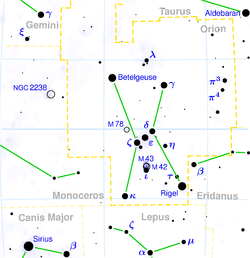Orionidi
| Orionidi (ORI) | |
|---|---|
 Meteor Orionidov (sredina desno) pod Rimsko cesto in desno od Venere. Na sliki je vidna tudi zodiakalna svetloba. | |
| Datum odkritja | oktober 1839[1] |
| Starševsko telo | 1P/Halley[2] |
| Radiant | |
| Ozvezdje | Orion (blizu Betelgeze) |
| Rektascenzija | 06h 24m[2] |
| Deklinacija | +15°[2] |
| Značilnosti | |
| Čas dejavnosti | 16. oktober – 27. oktober[2] |
| Datum vrhunca | 21. oktober[2] |
| Hitrost | 66,9[3] km/s |
| Zenitna urna frekvenca | typically 20–25[4] |

Orionidi so meteorji, ki pripadajo vsakoletnemu meteorskemu roju.
Radiant Orionidov leži v ozvezdju Oriona (Ori) (Orionis). Orionidi se pojavljajo od 16. oktobra do 27. oktobra, svoj vrhunec pa dosežejo 21. oktobra.
Starševsko telo (izvorni komet) je periodični Halleyev komet (obhodna doba okoli 76 let). Delci iz istega kometa povročajo tudi meteorski roj Eta Akvaridi.
Opazovanje
[uredi | uredi kodo]Orionidi spadajo med najmočnejše in najbolj opazovane meteorske roje. Radiant leži v severovzhodnem delu ozvezdja Orion (levo nad znano zvezdo Betelgezo). Ker ima komet Halley retrogradno orbito, imajo prašni delci iz kometa relativno veliko hitrost glede na Zemljo, ki jo zadenejo s hitrostjo do 66 km/s. Opazovalec vidi v jasni in temni noči okoli 10 meteorjev na uro.
Glej tudi
[uredi | uredi kodo]Sklici
[uredi | uredi kodo]- ↑ Jenniskens, Peter (2006), Meteor Showers And Their Parent Comets, Cambridge University Press, str. 9, ISBN 0521853494.
- ↑ 2,0 2,1 2,2 2,3 2,4 Moore, Patrick; Rees, Robin (2011), Patrick Moore's Data Book of Astronomy (2. izd.), Cambridge University Press, str. 275, ISBN 0-521-89935-4.
- ↑ Kero, J.; in sod. (Oktober 2011), »First results from the 2009-2010 MU radar head echo observation programme for sporadic and shower meteors: the Orionids 2009«, Monthly Notices of the Royal Astronomical Society, 416 (4): 2550–2559, Bibcode:2011MNRAS.416.2550K, doi:10.1111/j.1365-2966.2011.19146.x.
- ↑ Rendtel, Jürgen (2008), »The Orionid meteor shower observed over 70 years«, v Trigo-Rodríguez, J. M.; Rietmeijer, F. J. M.; Llorca, Jordi; Janches, Diego (ur.), Advances in Meteoroid and Meteor Science, Springer, str. 106–109, ISBN 0387784187.
Zunanje povezave
[uredi | uredi kodo]Text is available under the CC BY-SA 4.0 license; additional terms may apply.
Images, videos and audio are available under their respective licenses.
